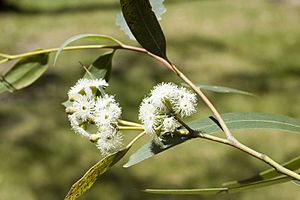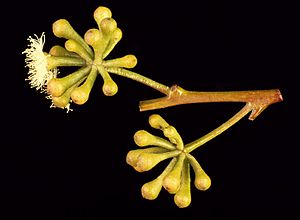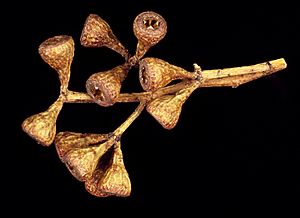Yertchuk facts for kids
Quick facts for kids Prickly stringybark |
|
|---|---|
 |
|
| Eucalyptus consideniana in the ANBG | |
| Scientific classification | |
| Genus: |
Eucalyptus
|
| Species: |
consideniana
|
The Eucalyptus consideniana, often called the yertchuk, is a special type of tree. It belongs to the myrtle family, just like many other gum trees. This tree is found only in south-eastern Australia. It has rough, fibrous, and sometimes prickly bark on its trunk and bigger branches. Higher up, the bark is smooth and grey. The yertchuk has long, curved leaves, white flowers, and cool, cone-shaped fruits.
Contents
What Does the Yertchuk Tree Look Like?
The Eucalyptus consideniana is a tree that usually grows up to 30 m (98 ft) tall. Sometimes, it can also grow as a mallee, which is a smaller, bushy tree with many stems. It has a special woody swelling at its base called a lignotuber. This helps the tree regrow if it gets damaged.
Its bark is grey, prickly, and fibrous on the main trunk and larger branches. On the thinner branches, the bark is smooth and grey or yellowish. This smooth bark often peels off in long ribbons.
Leaves and Flowers
Young yertchuk plants have leaves that are green to bluish and shaped like an egg or a spear. These leaves are about 75–165 mm (3.0–6.5 in) long and 12–72 mm (0.47–2.83 in) wide. They are also sessile, meaning they attach directly to the stem without a stalk.
Adult leaves are shiny green to grey-green on both sides. They are shaped like a spear or are slightly curved, measuring 65–180 mm (2.6–7.1 in) long and 10–30 mm (0.39–1.18 in) wide.
The yertchuk's flower buds grow in groups of eleven to nineteen. They appear in the axils of the leaves, which is the angle between a leaf and the stem. Each group of buds sits on a stalk called a peduncle, which is 5–14 mm (0.20–0.55 in) long. Each individual bud has its own smaller stalk, called a pedicel, about 3–8 mm (0.12–0.31 in) long.
Mature buds are oval or club-shaped, about 3–4 mm (0.12–0.16 in) long and 2–4 mm (0.079–0.157 in) wide. The yertchuk blooms between September and December, and its flowers are white.
Fruit
After flowering, the tree produces a woody fruit called a capsule. This capsule is shaped like a cone or half-sphere, measuring 5–9 mm (0.20–0.35 in) long and 6–8 mm (0.24–0.31 in) wide. It sits on a pedicel that is 2–8 mm (0.079–0.315 in) long.
How the Yertchuk Got Its Name
The Eucalyptus consideniana was officially described in 1904 by a scientist named Joseph Maiden. He found a sample of the tree in Springwood with another person named Henry Deane.
Maiden published his description in a scientific paper called Proceedings of the Linnean Society of New South Wales. He named the species consideniana to honor "First-Assistant Surgeon D. Considen." Dennis Considen was one of the people who helped start Australia. Maiden also mentioned that Considen might have been the first person to start the eucalyptus oil industry.
Where Does the Yertchuk Tree Grow?
The yertchuk tree usually grows in open forests where the soil doesn't drain very well. You can find this tree in areas between the cities of Sydney and Melbourne, along the coast and in the nearby tablelands.



